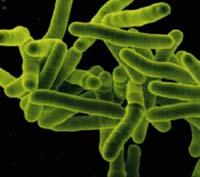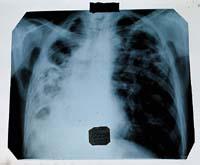Tuberculosis, an ancestral epidemic
2006/03/01 Belaustegi Irazabal, Ainara - Elhuyar Zientziaren Komunikazioa Iturria: Elhuyar aldizkaria

Abundant scrub and few results. This is how the fight against tuberculosis lasted for centuries. From the time of Hippocrates until the XIX. Until the mid-twentieth century, most doctors considered it a hereditary disease. From that erroneous idea, of course, an adequate treatment was difficult.
Thanks to the discovery of the Prussian doctor Robert Koch. He clarified that tuberculosis was not hereditary, but a contagious disease caused by a bacillus. Clarify it in form. The excessive growth of the urban population as a result of the European Industrial Revolution caused a favorable situation for the extension of tuberculosis. When Koch began his research in 1881, he caused one in seven deaths in Europe. It was a white plague.
Research by Koch
Koch first studied by microscope the diseased tissues of tuberculosis. As nothing special was seen, he thought it was what was to be done, that it was to dye. Today we know that the dyeing of Mycobacterium tuberculosis is very difficult due to the large amount of lipids it contains on its surface. Koch used a special dyeing procedure. He first dyed with blue alkaline methylene the tissue samples of the patients. Then he used a second coloring that only dyed the fabric, the bismark brown. With the new dyeing method, the bacilli were dyed in blue and the light brown fabric.
However, dyeing the bacilli was not enough. It had to be demonstrated that those bacilli caused tuberculosis. For this purpose, Koch was based on the principles postulated by him, later known as Koche's postulates. To begin with, he got the pure cultures of the bacteria. Subsequently, he inoculated microorganisms taken from these cultures to a healthy bunny. Seeing Akuria developing tuberculosis, it became clear that M. tuberculosis was the cause of the disease. In addition, from that sick animal, the bacterium could be isolated again and repeat the same process, that is to say, to infect tuberculosis to another organism.
Treatment yes, but...
Once the tuberculosis bacillus was identified, scientists looked for antibiotics against it. Streptomycin in the 1940s, isoniacida in 1950, ethanbutol in 1960 and rifanpine in 1970. By combining these antibiotics, a six-month treatment was proposed: during the first two months the patient should take between 3 and 4 antibiotics and during the next four months continue with 2 antibiotics, which are currently maintained.

Tuberculosis was on the way to extinction, but in the mid-1980s it took strength again. AIDS and the overpopulation of many cities and the lack of hygiene caused this fact. In addition, due to the long duration of treatment, some people interrupt it before its completion, which makes bacilli become resistant to antibiotics.
In 1993, the World Health Organization described tuberculosis as a serious global health problem and in 1994 the DOTS strategy was approved to combat it. The strategy includes the commitment of governments, bacteriological diagnosis and an effective laboratory network, short standardized chemotherapy...
Since then, 5 out of 6 countries in the world have decreased or TB has stabilized, although still far from disappearing. The exception is Africa. In states where the prevalence of HIV is high, tuberculosis has tripled its effect since 1990, and across the continent the percentage of people suffering from tuberculosis increases by 3-4% each year.
Tuberculosis, along with AIDS and malaria, is one of the diseases that die the most. There is treatment and if it is done correctly it is effective. There is the key. That in many places no antibiotic arrives, that what arrives is of poor quality, that many cut the treatment before time... Meanwhile, a third of the world is still contaminated and about 5,000 people die every day. Spend the day, come the day.




